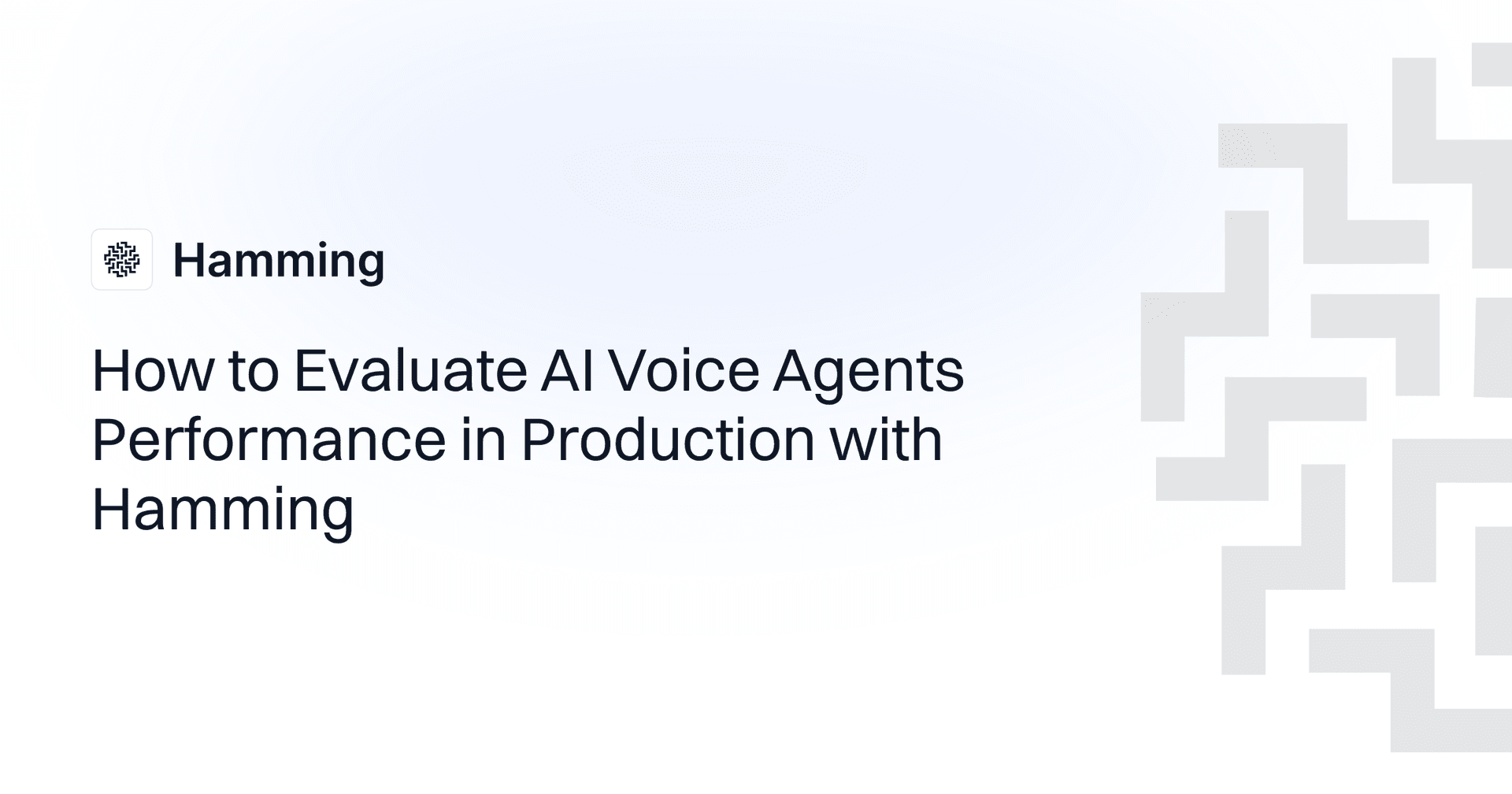How to Evaluate AI Voice Agents Performance in Production with Hamming
We had a customer whose voice agent started failing silently on Tuesdays. Not every Tuesday—just the ones after a Monday holiday. Took three weeks to figure out why: their scheduling integration cached weekend hours, and post-holiday Mondays threw off the cache invalidation. By the time they found it, they'd lost hundreds of bookings.
The frustrating part? The metrics looked fine. Latency was normal. Error rates were low. The agent wasn't crashing—it was just confidently giving users the wrong available times.
Voice agents handle thousands of calls daily, and failures are inevitable. But most teams discover those failures through customer complaints, after the call has ended. This reactive approach means issues get fixed after they've already impacted user experience.
Here's how to evaluate AI voice agents in production so you catch problems before your customers do.
Quick filter: If your first signal is a support ticket, you’re monitoring too late.
Set Up Real-Time Performance Tracking
Connect your voice infrastructure to Hamming through webhook integration in under 30 minutes:
const webhookConfig = {
url: "https://api.hamming.ai/v1/voice/webhook",
auth: {
apiKey: process.env.HAMMING_API_KEY
},
events: [
"call.started",
"call.ended",
"transcription.final",
"error.occurred"
],
metadata: {
environment: "production",
service: "voice-agent"
}
}These are the essential metrics to enable first:
- Latency tracking: P50, P95, and P99 response times
- Completion rates: Successful vs. failed interactions
- Error categorization: Technical failures vs. conversation breakdowns
Set thresholds based on your use case:
| Use Case | Latency P95 | Completion Rate | Error Rate |
|---|---|---|---|
| Customer Service | < 800ms | > 85% | < 5% |
| Sales Calls | < 1000ms | > 75% | < 8% |
| Technical Support | < 900ms | > 80% | < 6% |
Hamming tracks various voice-specific metrics like turn-level response time, time-to-first word, interruptions and silence gaps. These are indicators that correlate directly with user satisfaction. Grove AI maintains sub-800ms latency across 10,000+ daily production calls using these insights.
Monitor Metrics That Predict Success
Focus on these four metric layers that determine voice agent performance:
Layer 1: System Performance
Track latency across percentiles. P50 shows the median experience, P90 highlights slow tail performance, P95 and P99 uncover severe outliers, and the maximum exposes the absolute worst-case.
Configure alerts for:
- Latency spikes above threshold
- Availability drops below 99.9%
- Error rates exceeding baseline
Layer 2: Conversation Mechanics
Natural conversation indicators:
- Interruption rate: >1 per call signals timing problems
- Silence duration: Gaps >2 seconds break flow
- Turn-taking consistency: Measured by overlap patterns
Layer 3: Task Completion
Business outcomes:
- Intent recognition accuracy
- Task completion by flow type
- Transfer rate to human agents
- Handling time per task
A checkout flow needs 95% completion. Complex troubleshooting might accept 75%. Configure thresholds per workflow.
Layer 4: Sentiment Signals
Quality indicators:
- Conversation scores
- Frustration patterns (repeated phrases, tone changes)
- Resolution signals
Configure monitoring across all layers:
| Metric Category | Critical Threshold | Alert Type | Hamming Feature |
|---|---|---|---|
| Latency P95 | > 800ms | Immediate | Auto-detect |
| Interruptions | > 3 per call | Daily digest | Quality scoring |
| Task Completion | < 85% | Immediate | Custom monitoring |
| Quality Issues | > 2 per call | Review queue | AI evaluation |
Analyze Conversation Quality with AI Evaluations
Metrics show what happened. Quality analysis reveals why.
Start with pre-built evaluations:
- Politeness and professionalism
- Information accuracy
- Knowledge base and prompt compliance
- Escalation handling
Create custom evaluations for your needs:
evaluation_config = {
"name": "appointment_accuracy",
"criteria": [
"Confirms correct date and time",
"Verifies patient identity",
"Mentions preparation instructions",
"Offers reminder options"
],
"fail_conditions": [
"Books wrong department",
"Misses identity verification",
"Provides incorrect preparation"
],
"severity": "high"
}
hamming.create_evaluation(evaluation_config)Hamming's flow analysis identifies failure points. Common patterns include:
- Agents excelling at simple requests but struggling with multi-step processes
- Specific phrases that confuse the model
- Edge cases missing from training data
Chain evaluations for complex scenarios:
- Check if medical information was discussed
- If yes → Verify HIPAA compliance
- If no → Assess proper redirection
This analysis runs on every call, revealing patterns manual testing misses.
Configure Intelligent Alert Systems
An effective alert system enables engineers to fix problems easily.
Set threshold-based alerts for immediate issues:
alert_rules:
- metric: latency_p95
threshold: 800ms
window: 5_minutes
severity: critical
channel: pagerduty
- metric: error_rate
threshold: 5%
window: 10_minutes
severity: high
channel: slack_engineering
- metric: task_completion
threshold: 80%
window: 30_minutes
severity: medium
channel: slack_productConfigure anomaly detection for unusual patterns. Hamming identifies deviations from your baseline, for instance, a call duration increasing by 50% or transfer rates spiking during specific hours. Graduated quality alerts:
- Single failure: Log for review
- Pattern (3+ similar): Create ticket
- Widespread issue: Immediate notification Match escalation to operational reality: | Issue Type | Detection Method | Alert Channel | Response Time | |------------|-----------------|---------------|---------------| | System down | Error rate > 50% | PagerDuty | < 1 minute | | Performance degradation | Latency > threshold | Slack | < 15 minutes | | Quality issues | Evaluation failures | Email digest | Daily | | Edge cases | Pattern detection | Jira | Next sprint |
Hamming correlates related alerts. When latency spikes coincide with increased transfers, you receive one incident notification with full context, not three separate alerts.
Connect to existing systems:
hamming.configureWebhook({
url: "https://your-system.com/incidents",
events: ["critical_alert", "quality_degradation"],
include_transcript: true,
include_analysis: true,
custom_fields: {
team: "voice-platform",
service: "production-agent"
}
});Start simple. Refine based on actual response patterns.
Convert Production Issues into Test Cases
Every production failure becomes a permanent test case.
Capture exact failure scenarios:
test_case = {
"name": "Handle appointment rescheduling during holiday",
"scenario": "Customer calls to reschedule on Thanksgiving",
"expected_behavior": "Inform about closure, offer next available",
"actual_failure": "Agent attempted booking on closed day",
"test_type": "Voice Character simulation",
"frequency": "Every deployment"
}
hamming.create_test(test_case)Voice Characters simulate real callers with various accents, speaking styles, and communication patterns. They test exact production scenarios plus variations you haven't encountered.
Prioritize test creation by impact:
| Issue Type | Test Priority | Automation Level |
|---|---|---|
| Affects > 1% of calls | Critical | Every deployment |
| Compliance violation | Critical | Every deployment |
| Edge case (< 0.1%) | Medium | Weekly regression |
| Minor quality issue | Low | Monthly review |
Use pattern-based testing. When agents fail with "Thanksgiving," test "Christmas," "New Year's," and "Easter" automatically. This approach prevents entire categories of failures.
Build Actionable Dashboards
Different roles in an organization need different views.
Engineering Dashboard:
- Top: System health (latency histograms, error rates)
- Middle: Technical metrics (API times, concurrent calls)
- Bottom: Recent failures with recordings
Update frequency: Real-time
const engineeringDash = {
name: "Production Engineering View",
widgets: [
{ type: "latency_histogram", position: "top_left" },
{ type: "error_rate_timeline", position: "top_right" },
{ type: "concurrent_calls_gauge", position: "middle_left" },
{ type: "recent_failures_list", position: "bottom" }
],
alerts: ["critical", "high"],
refresh_rate: "1m"
};Product Dashboard:
- Top: Task completion by flow
- Middle: Feature usage and success
- Bottom: Journey analytics and drop-offs
Update frequency: Hourly
Executive Dashboard:
- Top: Business KPIs (volume, resolution, cost)
- Middle: Satisfaction and quality trends
- Bottom: Month-over-month improvements
Update frequency: Daily
Always include:
- North Star Metric: Primary success indicator
- Leading indicators: Predict problems
- Lagging indicators: Confirm impact
- Comparative metrics: Week-over-week performance
A Live AI Voice Agent Performance Evaluation
The cost of blind operation compounds daily. Every unmonitored day means undetected issues, preventable problems, and missed improvements. Teams with proper monitoring learn faster and serve customers better.
Book a demo to see an AI voice agent performance evaluation live.

